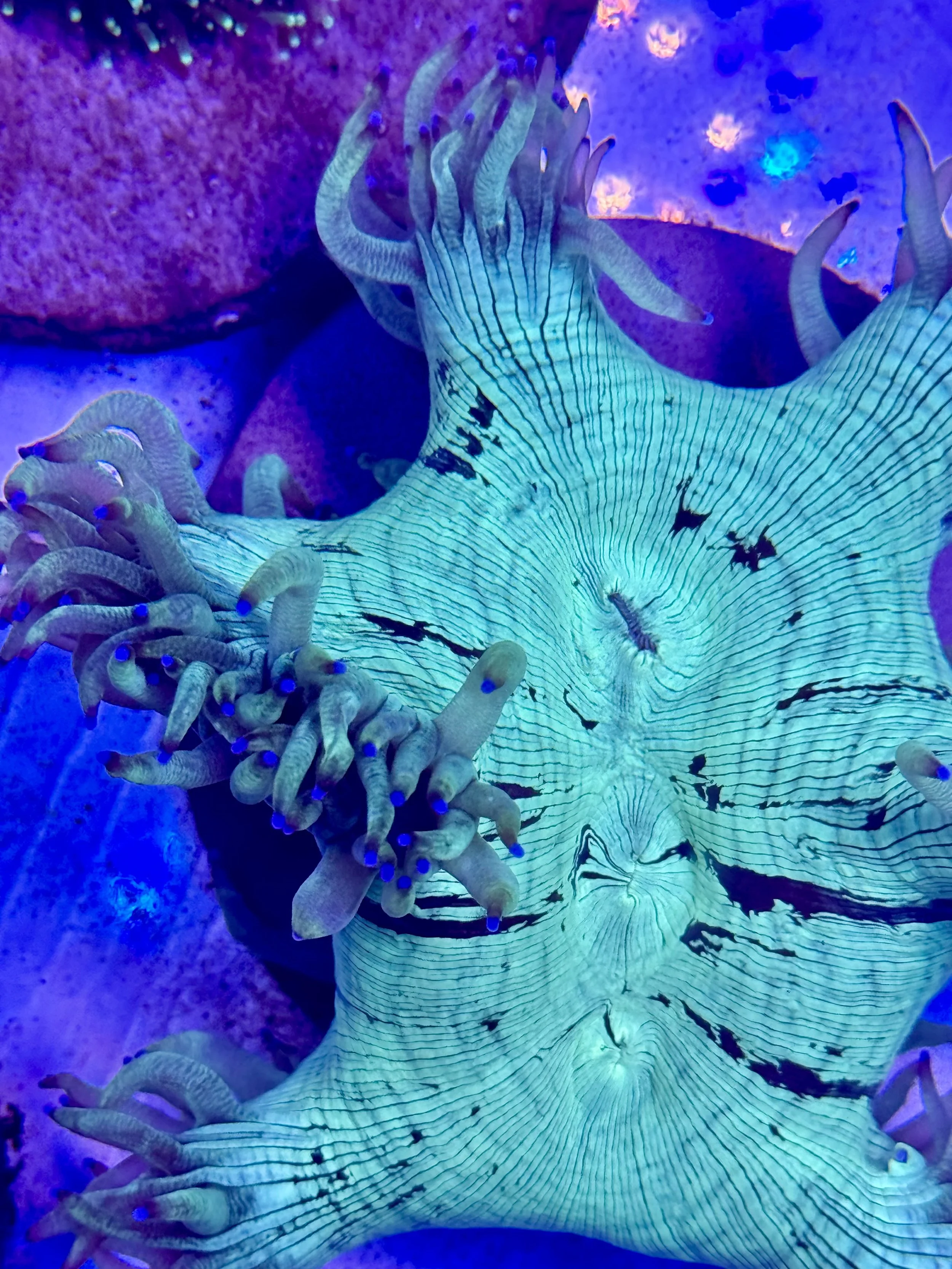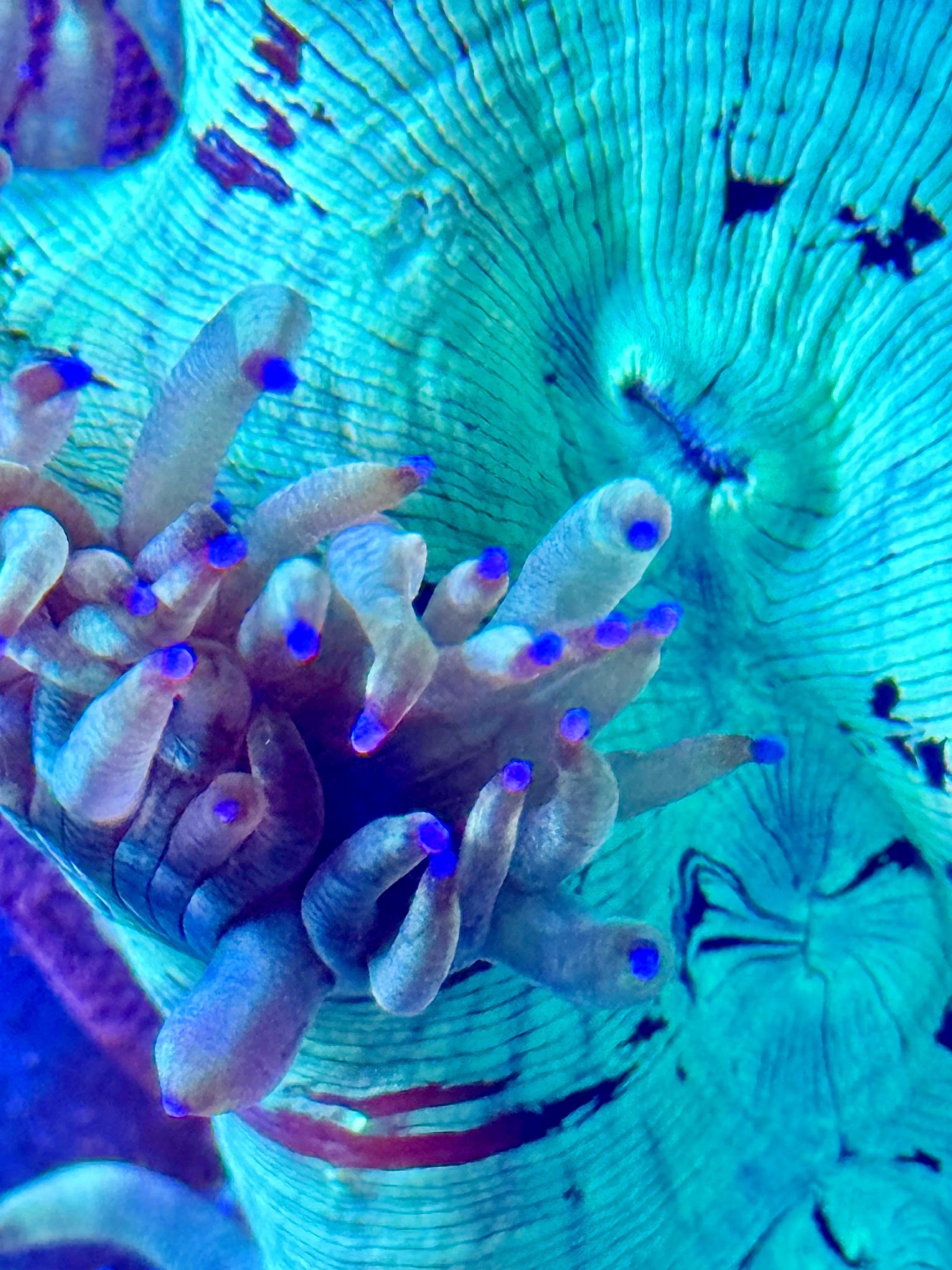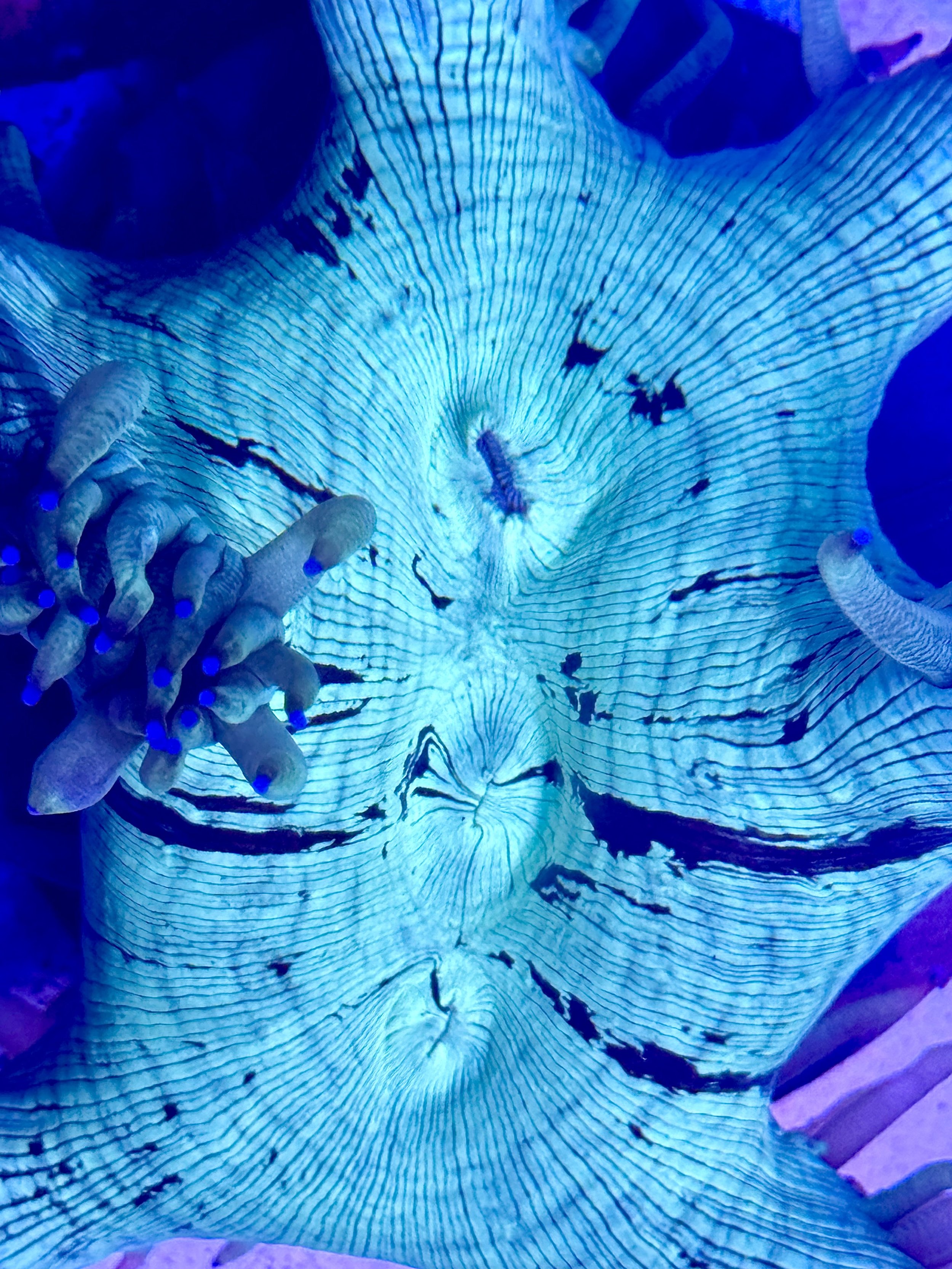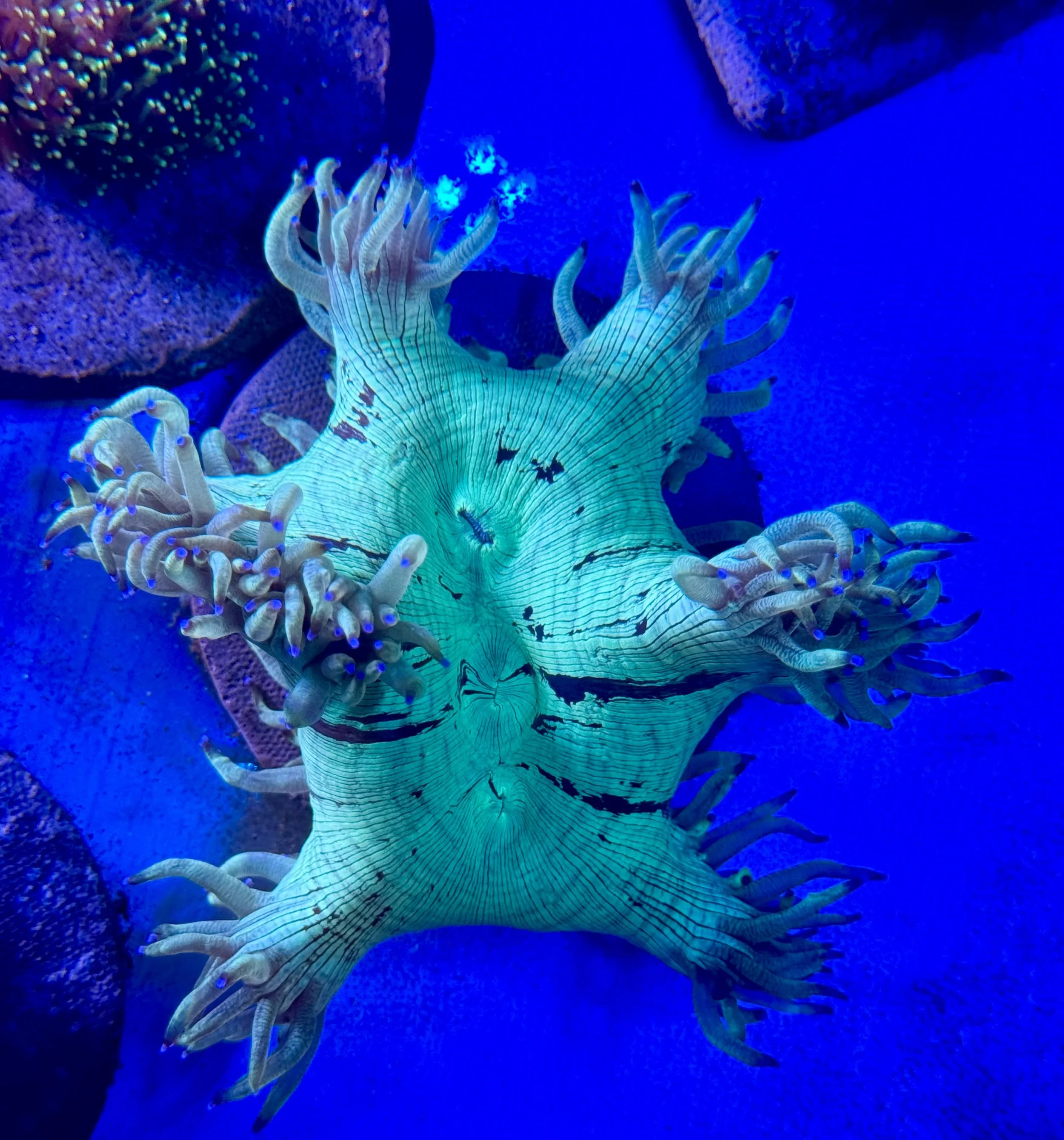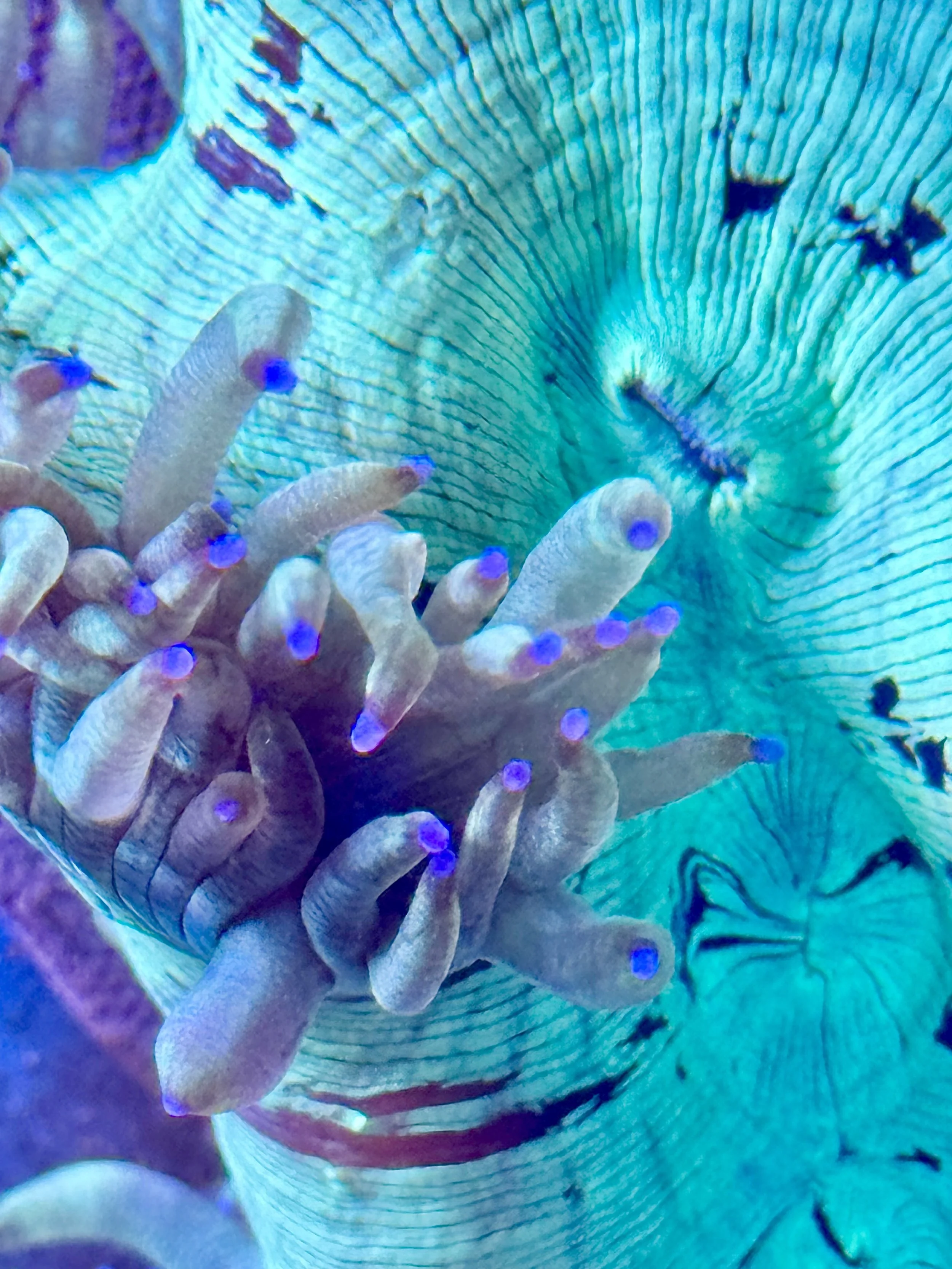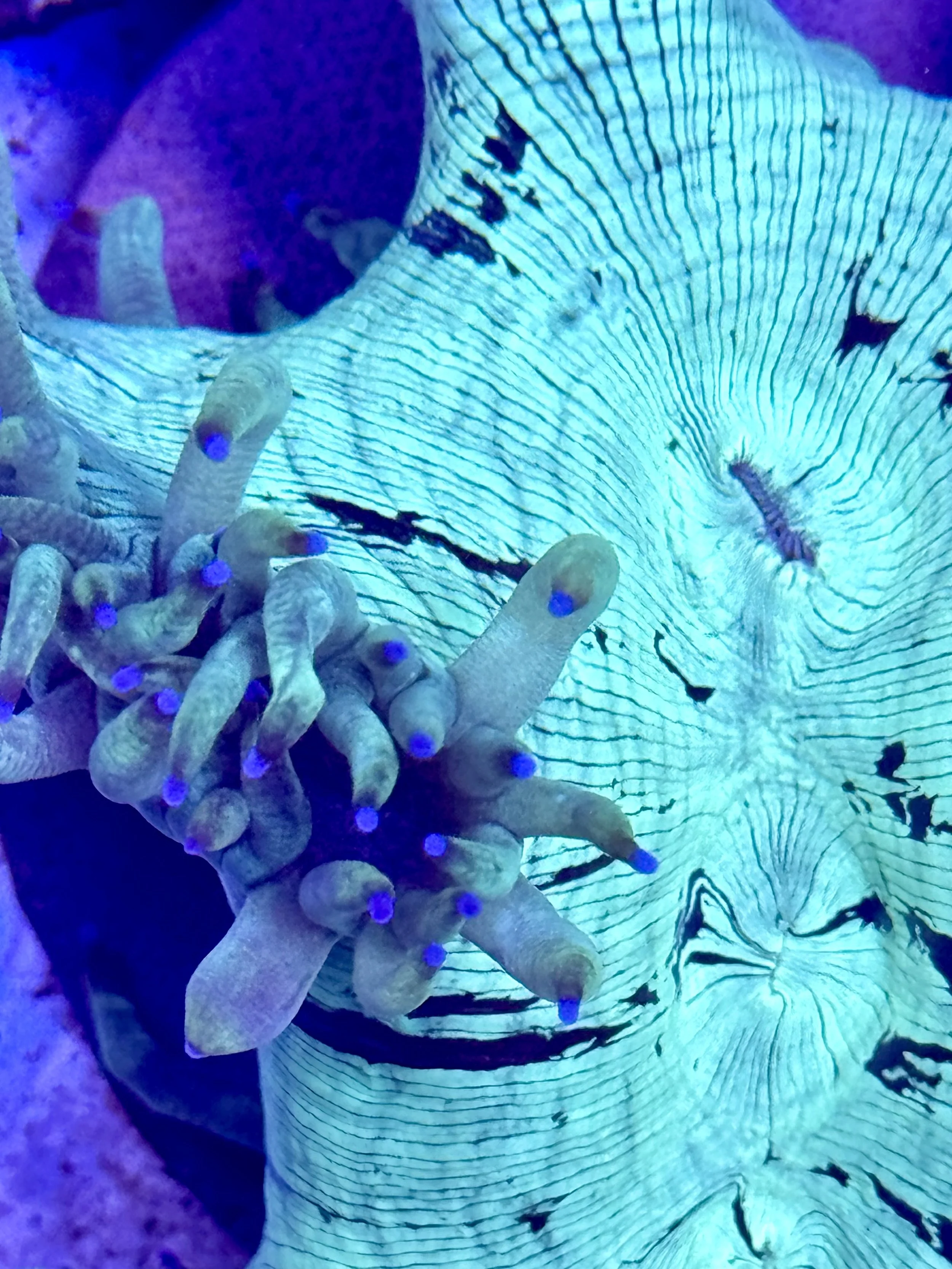Elegance Coral (Catalaphyllia jardinei) – Live Aquaculture LPS Coral
Classification: Premium Large Polyp Stony (LPS) Coral
The Elegance Coral (Catalaphyllia jardinei) is a stunning centerpiece LPS coral, admired for its flowing tentacles, bright coloration, and graceful movement. Known for its vibrant neon green body, purple or pink tips, and long, waving polyps, this coral adds both motion and brilliance to any reef display. When placed under actinic or blue LED lighting, its fluorescent pigments glow intensely — creating a captivating, dynamic visual effect.
Each aquacultured specimen from coralSLover® is carefully propagated and raised in controlled systems to ensure tank stability, pest-free growth, and sustainable lineage. Our specimens are fully healed, acclimated to aquarium life, and selected for strong color, health, and resilience.
Scientific Information
Scientific Name:Catalaphyllia jardinei
Common Names: Elegance Coral, Wonder Coral, Ridge Coral, Elegant Cat’s Eye Coral
Family: Euphylliidae
Distribution: Indo-Pacific, Great Barrier Reef, Coral Sea, South China Sea
Growth Form: Free-living or attached LPS with meandering valleys and large fleshy polyps extending from a calcified skeleton
Coloration: Fluorescent green to turquoise oral disc, often with pink, lavender, or purple tentacle tips
Symbiosis: Contains Symbiodiniaceae (zooxanthellae) for photosynthesis
Feeding Behavior: Captures particulate foods with sticky tentacles and benefits from target feeding
Reproduction: Asexual budding and tissue regeneration from skeletal ridges
Care & Placement for Elegance Coral
Lighting: Moderate; strong actinic or blue light enhances fluorescence but avoid direct high-intensity light to prevent tissue stress.
Flow: Gentle, indirect flow that allows tentacles to sway freely without excessive whipping.
Placement: Lower to mid reef zones or substrate areas; provide open space to prevent contact with other corals, as Elegance Corals possess potent stinging tentacles.
Feeding: Accepts meaty foods such as mysis, brine shrimp, or finely chopped seafood 1–2 times per week. Supplemental feedings promote faster growth and color vibrancy.
Behavior: Semi-aggressive; extended tentacles can sting nearby corals up to 3–4 inches away.
Water Parameters
Growth & Behavior
The Elegance Coral expands dramatically when healthy, its polyps flowing gracefully in the current. It prefers a stable, nutrient-balanced system and can grow into large, fleshy colonies up to 10 inches across under optimal conditions. Periodic feeding and consistent water chemistry are key to maintaining its vivid coloration and expansion.
Our coralSLover® aquaculture strain has been tank-raised for multiple generations, ensuring adaptability, disease resistance, and exceptional color retention — superior to many wild-sourced specimens.
Scientific Background
First described by Wells in 1971, Catalaphyllia jardinei is native to shallow lagoons and reef slopes where it anchors in sandy or muddy substrates. Its large, fleshy polyps form extensive tentacles that resemble anemones, which protect its soft tissues and facilitate food capture.
Modern reef research highlights the Elegance Coral’s bioluminescent and fluorescent proteins, which serve to regulate light intensity and protect its symbiotic algae. In aquaria, these same pigments give rise to its brilliant glow — a defining feature for reef enthusiasts worldwide.
Great For
Intermediate to advanced reef aquarists looking for a graceful, high-visual-impact LPS coral that brings movement, elegance, and fluorescence to the reefscape.
Additional Notes
Please note that the coral shown in the photo represents a typical example of this species or morph — not the exact coral you will receive.
Because these corals come from our trusted wholesale partners, each piece may vary slightly in color, pattern. You may receive a coral with tones of red, blue, purple, green, or multicolor, sometimes with different center shades or markings.
We always hand-select the best available specimen for you from current stock to ensure quality, color, and health.
Availability Notice:
This coral may currently be out of stock or available for pre-order. Inventory depends on availability from our trusted wholesaler partners.
If you’re interested in this coral or have any questions about upcoming availability, please contact us directly — we’ll be happy to assist or reserve one for you.
If you are looking for a specific color or variation, please contact us directly — we’re happy to help locate or reserve one that fits your request.
Free Shipping When Qualified.
Elegance Coral (Catalaphyllia jardinei) – Live Aquaculture LPS Coral
Classification: Premium Large Polyp Stony (LPS) Coral
The Elegance Coral (Catalaphyllia jardinei) is a stunning centerpiece LPS coral, admired for its flowing tentacles, bright coloration, and graceful movement. Known for its vibrant neon green body, purple or pink tips, and long, waving polyps, this coral adds both motion and brilliance to any reef display. When placed under actinic or blue LED lighting, its fluorescent pigments glow intensely — creating a captivating, dynamic visual effect.
Each aquacultured specimen from coralSLover® is carefully propagated and raised in controlled systems to ensure tank stability, pest-free growth, and sustainable lineage. Our specimens are fully healed, acclimated to aquarium life, and selected for strong color, health, and resilience.
Scientific Information
Scientific Name:Catalaphyllia jardinei
Common Names: Elegance Coral, Wonder Coral, Ridge Coral, Elegant Cat’s Eye Coral
Family: Euphylliidae
Distribution: Indo-Pacific, Great Barrier Reef, Coral Sea, South China Sea
Growth Form: Free-living or attached LPS with meandering valleys and large fleshy polyps extending from a calcified skeleton
Coloration: Fluorescent green to turquoise oral disc, often with pink, lavender, or purple tentacle tips
Symbiosis: Contains Symbiodiniaceae (zooxanthellae) for photosynthesis
Feeding Behavior: Captures particulate foods with sticky tentacles and benefits from target feeding
Reproduction: Asexual budding and tissue regeneration from skeletal ridges
Care & Placement for Elegance Coral
Lighting: Moderate; strong actinic or blue light enhances fluorescence but avoid direct high-intensity light to prevent tissue stress.
Flow: Gentle, indirect flow that allows tentacles to sway freely without excessive whipping.
Placement: Lower to mid reef zones or substrate areas; provide open space to prevent contact with other corals, as Elegance Corals possess potent stinging tentacles.
Feeding: Accepts meaty foods such as mysis, brine shrimp, or finely chopped seafood 1–2 times per week. Supplemental feedings promote faster growth and color vibrancy.
Behavior: Semi-aggressive; extended tentacles can sting nearby corals up to 3–4 inches away.
Water Parameters
Growth & Behavior
The Elegance Coral expands dramatically when healthy, its polyps flowing gracefully in the current. It prefers a stable, nutrient-balanced system and can grow into large, fleshy colonies up to 10 inches across under optimal conditions. Periodic feeding and consistent water chemistry are key to maintaining its vivid coloration and expansion.
Our coralSLover® aquaculture strain has been tank-raised for multiple generations, ensuring adaptability, disease resistance, and exceptional color retention — superior to many wild-sourced specimens.
Scientific Background
First described by Wells in 1971, Catalaphyllia jardinei is native to shallow lagoons and reef slopes where it anchors in sandy or muddy substrates. Its large, fleshy polyps form extensive tentacles that resemble anemones, which protect its soft tissues and facilitate food capture.
Modern reef research highlights the Elegance Coral’s bioluminescent and fluorescent proteins, which serve to regulate light intensity and protect its symbiotic algae. In aquaria, these same pigments give rise to its brilliant glow — a defining feature for reef enthusiasts worldwide.
Great For
Intermediate to advanced reef aquarists looking for a graceful, high-visual-impact LPS coral that brings movement, elegance, and fluorescence to the reefscape.
Additional Notes
Please note that the coral shown in the photo represents a typical example of this species or morph — not the exact coral you will receive.
Because these corals come from our trusted wholesale partners, each piece may vary slightly in color, pattern. You may receive a coral with tones of red, blue, purple, green, or multicolor, sometimes with different center shades or markings.
We always hand-select the best available specimen for you from current stock to ensure quality, color, and health.
Availability Notice:
This coral may currently be out of stock or available for pre-order. Inventory depends on availability from our trusted wholesaler partners.
If you’re interested in this coral or have any questions about upcoming availability, please contact us directly — we’ll be happy to assist or reserve one for you.
If you are looking for a specific color or variation, please contact us directly — we’re happy to help locate or reserve one that fits your request.
Free Shipping When Qualified.

